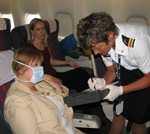U.S. Quarantine Stations
PDF version for printing [PDF – 2 pages]
Purpose
U.S. Quarantine Stations are part of a comprehensive system that serves to limit the introduction and spread of contagious diseases in the United States. They are located at 20 ports of entry and land-border crossings where most international travelers arrive (see map below).
They are staffed with medical and public health officers from the Centers for Disease Control and Prevention (CDC) and managed by CDC’s Division of Global Migration and Quarantine. These health officers decide whether ill persons can enter the United States and what measures should be taken to prevent the spread of contagious diseases.
DGMQ currently staffs 18 of CDC’s 20 quarantine stations. Dallas and Boston fall under the jurisdiction of the quarantine stations in Houston and New York respectively.

Authority and Scope
CDC has the legal authority to detain any person who may have an infectious disease that is specified by Executive Order to be quarantinable. If necessary, CDC can deny ill persons with these diseases entry to the United States. CDC also can have them admitted to a hospital or confined to a home for a certain amount of time to prevent the spread of disease.
Daily Activities
Medical and public health officers at U.S. Quarantine Stations perform these activities:
Response
- Respond to reports of illnesses on airplanes, maritime vessels, and at land-border crossings
- Distribute immunobiologics and investigational drugs
- Plan and prepare for emergency response
Quarantinable Diseases by Executive Order
- Cholera
- Diphtheria
- Infectious tuberculosis
- Plague
- Smallpox
- Yellow fever
- Viral hemorrhagic fevers
- Severe acute respiratory syndromes
- New types of flu (influenza) that could cause a pandemic
Migration
- Monitor health and collect any medical information of new immigrants, refugees, asylees, and parolees
- Alert local health departments in the areas where refugees and immigrants resettle about any health issues that need follow up
- Provide travelers with essential health information
- Respond to mass migration emergencies
Inspection
- Inspect animals, animal products, and human remains that pose a potential threat to human health
- Screen cargo and hand-carried items for potential vectors of human infectious diseases
Partnerships
- Build partnerships for disease surveillance and control


Partners in Protection
CDC relies on an important network of partners who are part of the comprehensive system that supports the public health work of the U.S. Quarantine Stations. These partners include the following:
Government agencies
U.S. Customs and Border Protection, U.S. Fish and Wildlife Service, U.S. Department of Agriculture: Animal Plant and Health Inspection Services, U.S. Coast Guard, U.S. Food and Drug Administration, U.S. Department of State, U.S. Department of Homeland Security, U.S. Department of Transportation, Federal Aviation Administration, Transportation Security Administration, and the Federal Bureau of Investigation
Travel industry
Port officials, airlines, and cruise lines
Medical care
Emergency Medical Services, local and state public health departments, state public health laboratories, state and territorial epidemiologists, hospitals, and health care providers
International
Canadian/Mexican border authorities, World Health Organization, Public Health Agency of Canada, overseas panel physicians, International Organization for Migration, and foreign governments
Brief U.S. Quarantine History
- 1799 The first quarantine station and hospital in America was built in 1799 at the port of Philadelphia after a yellow fever outbreak in 1793.
- 1878 The National Quarantine Act was passed in 1878, shifting quarantine powers from state to federal government.
- 1944 The Public Health Service Act formed the federal government’s quarantine authority in 1944.
- 1967 CDC (National Communicable Disease Center) took over federal quarantine functions in 1967.
- 1970s CDC reduced the number of quarantine stations from 55 to 8 because infectious diseases were thought to be a thing of the past.
- 2004–2007 Number of quarantine stations increased to 20 because of concerns about bioterrorism after World Trade Center attack in 2001 and worldwide spread of disease after SARS outbreak in 2003.
- Page last reviewed: September 29, 2017
- Page last updated: September 29, 2017
- Content source:


 ShareCompartir
ShareCompartir